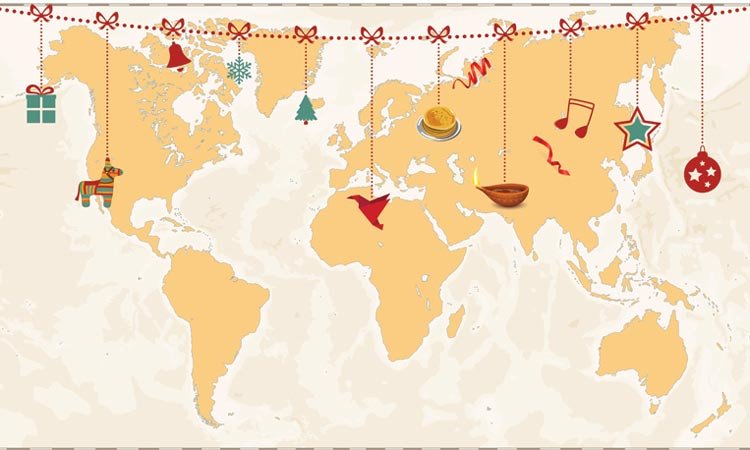Christmas is a time of joy and celebration. Many countries have unique customs and traditions that help make this a happy season.
- In Mexico, starting nine days before Christmas Day, children go through their neighborhoods reenacting Joseph and Mary’s search for lodging. Two children carrying figures of Joseph and Mary lead a procession to a particular house singing Christmas carols as they go. They knock on the door and ask for a room. At first they are refused, but then they are allowed in. A feast and celebration follow. Blindfolded children enjoy using a stick to try to break the piñata, a large brightly decorated papier-mâché figure hung from the ceiling and containing candy or small gifts.
- In Ireland, a candle is lit and put in the window on Christmas Eve to welcome any weary travelers.
- In Scotland, on the night after Christmas, boxes of food are wrapped and given to the poor.
- In Russia, some Orthodox Christians fast during a period before Christmas. Then, at the sight of the first star in the sky on Christmas Eve, a 12-course supper begins.
- In Greece, children go from house to house on Christmas Eve, knocking on doors and singing songs that herald the arrival of the Christ Child.
- In Ghana, West Africa, the houses are decorated with bright paper ornaments made by the families for the occasion. A tree in the courtyard of each house—often a mango, guava, or cashew tree—is also decorated.
- In Ethiopia, members of the Ethiopian Orthodox Church celebrate Christmas on January 6, following the ancient Roman calendar.
- In southern India, Christians decorate their houses with clay lamps at night.
- In the Philippines, Christmas carols start filling the airwaves as early as September.
- In China, Christians build artificial trees—called “trees of light”—and decorate them with paper chains, flowers, lanterns, and other ornaments.
- Americans decorate their houses with brightly colored lights. In some parts of the country they also line the streets with candles.
In many countries, nativity scenes are displayed to remind everyone of the birth of Jesus. In Italy, the family prays as the mother puts the figure of the Christ Child (Bambino) in the manger.
Around the world, bells are rung on joyous occasions. What more joyous occasion could there be than that of celebrating God’s love gift to the world, His only Son? Throughout Norway, people ring in Christmas by ringing bells at 5:00 p.m. on Christmas Eve.
And there is the Christmas tree, of course. There is considerable speculation as to how and when the evergreen became a symbol of Christmas, but many believe it can be traced to medieval Germany, where the Paradeisbaum, or Paradise tree, a type of evergreen, was decorated with red apples and used in a popular play about Adam and Eve that was put on at Christmastime, which ended with the promise of the coming Savior. The fact that the tree is always green symbolizes the eternal life that Jesus promises those who believe in Him. Just as the evergreen thrives even in winter, so Christ was triumphant over death.
Christians in times past decorated their homes with the holly tree at Christmastime. They called it the “holy tree,” as the prickly leaves reminded them of the crown of thorns that Jesus wore when He was crucified, and the red berries reminded them of the blood He shed for the forgiveness of our sins.
Perhaps the most widespread of all Christmas traditions—the giving of gifts to loved ones—has its roots in the gifts the wise men presented to Jesus. They had seen a sign in the heavens that signaled the Messiah’s birth, and they went to worship Him and presented His family with gifts of gold, frankincense, and myrrh. The gift of gold signified His royalty. The gift of frankincense signified His divinity. It was an aromatic resin from which incense and perfume fit for kings were made. Myrrh, the third gift, was another aromatic resin, from which perfume was made to embalm the dead. This signified Jesus’ humanity and that He would die for us. Jesus’ birth, suffering, death, and glory were all revealed in the wise men’s gifts.
But why all these traditions? Let’s travel back to the first Christmas Eve, where some shepherds are taking care of their flocks on a hillside near Bethlehem. A bright light bursts forth and angels announce the birth of Jesus in song. The shepherds are so excited that they run and tell everyone they can about what just happened. Imagine the joy that Mary and Joseph experienced when they held God’s Son in their arms! That same unspeakable joy can still be felt today by all those who open their hearts to receive God’s love in Jesus.
